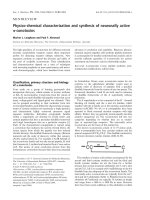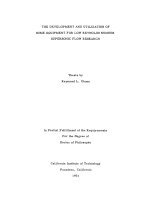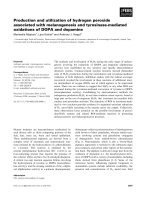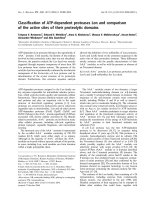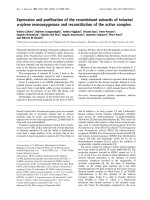Processing and utilization of Satavari roots for preparation of herbal Aonla ladoo
Bạn đang xem bản rút gọn của tài liệu. Xem và tải ngay bản đầy đủ của tài liệu tại đây (212.14 KB, 9 trang )
Int.J.Curr.Microbiol.App.Sci (2018) 7(3): 2698-2706
International Journal of Current Microbiology and Applied Sciences
ISSN: 2319-7706 Volume 7 Number 03 (2018)
Journal homepage:
Original Research Article
/>
Processing and Utilization of Satavari Roots for Preparation of
Herbal Aonla Ladoo
Jyoti Prabha Bishnoi1*, Rakesh Gehlot2, S. Siddiqui2 and Isha Kaushik2
1
Amity institute of Biotechnology, Amity University Rajasthan, Jaipur-303002,
Rajasthan, India
2
Centre of Food Science and Technology, CCS Haryana Agricultural University,
Hisar-125 004, Haryana, India
*Corresponding author
ABSTRACT
Keywords
Herbal, Satavari,
Aonla, Chakaiya,
Ladoo, Sensory
characteristics
Article Info
Accepted:
24 February 2018
Available Online:
10 March 2018
Satavari is known as queen of herbs. Active chemical constituents of Shatavari are
Sarsapogenin, Saponins A-4 to A-7, Shatavarin I to IV, Sitosterol, Glycosides of quercetin,
Stigmasterol, Asparagamine A and Sitosterol 7. High temperature during processing has
no effect on these active constituents. Hence attempt was made to utilize satavari roots
powder for preparation of herbal aonla ladoo. Satavari roots were processed to prepare
powder and herbal aonla ladoo using satavari powder (2, 4 and 6%) were developed and
evaluated. On the basis of sensory analysis, herbal aonla ladoo using satavari powder (4%)
was found most acceptable. The freshly prepared herbal aonla ladoo containing satavari
powder was analyzed for various chemical characteristics. The moisture content (35.3%),
total soluble solids (63.3%), total sugars (52.7%), reducing sugars (28.2%), titratable
acidity (1.46%), ascorbic acid (257 mg/100 g), pectin (0.43%), total phenols (1.99 mg/g)
and non-enzymatic browning (0.13) were recorded for herbal aonla ladoo containing
satavari powder (4%).Thus, present study was first in its kind to determine overall
acceptability, chemical composition and effect of storage period on chemical constituents
of herbal aonla ladoo obtained from aonla fruits cv. Chakaiyaand satavari root powder.
Introduction
Aonla (Phyllanthus emblica L.) is one of the
oldest Indian fruits and considered as
“Wonder fruit for health”. The fresh fruits are
not popular as a table fruit due to its high
acidity and astringent taste (Kumar and Nath,
1993). Further, aonla, being perishable, loses
its nutritional value in absence of proper postharvest technology; therefore, it is not popular
as a table fruit, but has a great potential in
processed forms. Several value added products
have been developed from aonla such as
pickles, preserve (murrabba), candy, sauce,
chutney, jam, jelly, spread and ladoo. Aonla
ladoo is prepared from aonla shreds. It is ballshaped, exceedingly sweet, highly flavourful
and easily masticated product. Expanding
knowledge of the role of physiologically
active food components, from both plant
(phytochemicals) and animal (zoo-chemicals)
sources, has notably changed the role of diet
2698
Int.J.Curr.Microbiol.App.Sci (2018) 7(3): 2698-2706
in health. This has led to the development of a
new generation of foods termed functional
foods. Functional foods are generally
described as foods and beverages that provide
health benefits beyond their inherent
nutritional value. Increased consumer interest
in improving overall health and reducing risk
for specific diseases has fuelled the demand
for foods that provide health benefits beyond
their traditional nutritional value (i.e., socalled functional foods).Nutritional and
medicinal qualities of ladoo can be enriched
by addition of ingredients such as medicinal
plant extract or powder (Reddy et al., 2005).
Herbal inclusion not only gives medicinal
qualities but can also give new flavor to the
product.
Satavari (Asparagus racemosus) is an
indigenous medicinal plant of the family
Liliaceae. It is commonly known as Satavar or
Satamuli in Hindi and is a perennial climbing
shrub with fleshy roots. Satavari is known as
queen of herbs, mainly used in Ayurveda and
Unani systems of medicine. Species of
Shatavari are found throughout India
especially in northern India. Chemical
constituents of Shatavari are Sarsapogenin,
Saponins A-4 to A-7, Shatavarin I to IV,
Sitosterol,
Glycosides
of
quercetin,
Stigmasterol, Asparagamine A and Sitosterol
7 (Hayes et al., 2006). The roots of plant are
considered to be effective as antispasmodic,
appetizer, stomach tonic, aphrodisiac,
galactogogue, astringent, anti-diarrheal, antidysenteric, laxative, anti-cancer, antiinflammatory (Tripathi et al., 2007) blood
purifier, anti-tubercular, anti-epileptic and also
in night blindness, kidney problems and in
throat complaints. Satavari is mentioned as
medhya-the plants which increase intelligence,
promote learning and memory, and as
rasayana-the rejuvenator herbs, which
improve health by increasing immunity,
vitality and resistance, imparting longevity as
well as protection against stress. Besides
these, Asparagus is a well-known source of
the amino acid Asparagine, a non-essential
amino acid in humans. Asparagine is a betaamido derivative of aspartic acid and plays an
important role in the biosynthesis of
glycoproteins and other proteins. The present
study was thus taken up to determine chemical
composition and overall acceptability of
herbal aonla ladoo obtained by utilization
satavari roots powder.
Materials and Methods
Roots of satavari were cleaned, washed and
dried in cabinet dryer at 50°C.Dried roots
were ground to fine powder (Plate No. 1) in a
hammer mill, packed in LDPE bags and stored
at room temperature for use in aonla ladoo.
Satavari roots powder (2, 4 and 6%) was
mixed with aonla pulp for preparation of
herbal aonla ladoo. Aonla ladoo (control) were
prepared by using 1 kg aonla pulp, 750 g sugar
and 1 g cardamom powder (small) as per the
procedure shown in flow sheet (Fig. 1). On
basis of sensory evaluation, optimum quantity
of satavari roots powder was standardized for
the preparation of herbal aonla ladoo. For
processing aonla ladoo, the mixture was
cooked till desired consistency was obtained.
The product was then cooled, rolled into ladoo
and packed in polypropylene (PP) boxes. The
freshly prepared herbal aonla ladoo containing
satavari powder was analyzed for various
chemical characteristics. Total soluble solids
(TSS) were estimated at ambient temperature
by hand refractometer (0-32%) and the values
were expressed as percent TSS. Ascorbic acid
was analyzed according to AOAC (1990)
method. Non- enzymatic browning (NEB) was
determined according to the method of
Ranganna (2008). Total phenols were
analyzed as per the methods given by
Amorium et al., (1997), while organoleptic
evaluation by using 9 point hedonic scale. The
moisture content of herbal aonla ladoo was
determined by Dean and Stark method. The
2699
Int.J.Curr.Microbiol.App.Sci (2018) 7(3): 2698-2706
water activity of processed products was
recorded by water activity meter (Labswiftaw,
Novasina, Switzerland). The instrument was
calibrated with water activity meter calibration
humidity salts (11, 58 and 84%). Sugars were
estimated by the method of Hulme and Narain
(1931). Total phenols (expressed as tannins)
were estimated by the Amorium et al., (1997).
Antioxidant activity was measured using
stable 2, 2-diphenyl-1-picrylhydrazyl (DPPH)
radical as per the method described by
Shimada et al., (1992).
Results and Discussion
Organoleptic quality of herbal aonla ladoo
The data pertaining to effects of incorporation
of various levels of supplements (satavari) on
sensory attributes of aonla ladoo variants has
been shown in Table 1. Aonla ladoo were
evaluated for sensory attributes viz., colour
and appearance, taste, texture, mouthfeel and
overall acceptability. Mean score for colour
and appearance, taste, texture, mouthfeel and
overall acceptability of control aonla ladoo
were 8.2, 8.1, 8.0, 8.0 and 8.0, respectively. In
herbal aonla ladoo, no significant change in
mean score of various sensory attributes was
noticed with incorporation of satavari powder
upto 4%. However, the mean score for sensory
attributes viz., colour and appearance taste,
texture, mouth feel and overall acceptability of
herbal aonla ladoo containing 6% satavari
powder, respectively was significantly lower
thancontrol. Overall acceptability scores
indicate that herbal aonla ladoo containing 6%
satavari powder, respectively were “Neither
liked nor disliked”. Thus, formulations
containing 4% satavari powder were selected
for preparation of herbal aonla ladoo.
Chemical constituents of herbal aonla ladoo
Changes in moisture %, water activity, total
soluble solids (TSS), total sugar, reducing
Sugar, Titratable acidity, ascorbic acid, total
phenols,
non-enzymatic
browning,
Antioxidant activity and pectin in herbal aonla
ladoo during three months storage period in
present study have been presented in Table 2.
The moisture content of herbal aonla ladoo
containing 4% satavari was found decreased
significantly during three months storage. This
may be due to evaporation of moisture from
the samples at room temperature during
storage. Singh et al., (2010) reported a decline
in moisture content of intermediate moisture
baby corn during storage. Singh et al., (2012)
also reported decrease in moisture content in
aonla supari during 135 days of storage
period. Water activity of herbal aonla ladoo
ranged from 0.75 to 0.67 during three months
of storage. The progressive decrease in aw of
herbal aonla ladoo during storage might be
due to loss of moisture content from the
samples. Ayub and Alam (2002) reported
decline in aw of dehydrated sweetened guava
slices. Singh et al., (2012) also reported
decline in water activity of aonla supari during
135 days storage period.
Total soluble solids were found to increase
significantly in herbal aonla ladoo during three
months storage. This might be due to
conversion of polysaccharides into soluble
sugars by hydrolysis process and reduction in
moisture content of the product during
storage. Similar results were reported by Ayub
et al., (2005) in sweetened guava slices, Daisy
et al., (2007) in aonla preserve, Goyal et al.,
(2008) in aonla candy, Ram et al., (2011) in
aonla bael blended RTS beverage and
Choudhary et al., (2012) in aonla nectar.
There was a gradual and significant increase
in total sugars of herbal aonla ladoo with the
advancement of storage period. The increase
in level of sugars can be attributed to loss of
moisture from the products and hydrolysis of
starch and pectin into simple sugars. Similar
finding were reported by Ram et al., (2011) in
aonla bael blended RTS beverage and
2700
Int.J.Curr.Microbiol.App.Sci (2018) 7(3): 2698-2706
Choudhary et al., (2012) in aonla nectar,
Gaikwad et al., (2013) in aonla ginger RTS
beverage and Patel et al., (2013) in aonla
murabba. Reducing sugars of herbal aonla
ladoo ranged from 28.2to 31.2 during three
months of storage. The increase in reducing
sugars corresponds to increase in total soluble
solid (TSS). Thus, it could be due to moisture
loss and inversion of non-reducing into
reducing sugars by hydrolysis. Rani and
Bhatia (1986) also showed an increase in
reducing sugars during 24 weeks storage of
Bagughosa preserve, which was ascribed to
increased inversion of sugars. Similar results
were also reported by Mir and Nath (1993) in
fortified mango bar, Sivakumar et al., (2007)
in guava toffee, Nagpal and Rajyalakshmi
(2009) in bael-citrus fruit blend and Panwar
(2014) in IMF aonla segments and aonla
candy. Gradual and significant increase in
titratable acidity of herbal aonla ladoo was
observed during three months storage. The
increase in acidity might be due to conversion
of sugar into acids (Manivasgan et al., 2006),
degradation of polyphenols and conversion of
proteins to amino acids. Pectic acid has also
been reported to increase the acidity in fruit
products; hence, degradation of insoluble
pectic substances into soluble pectate might
also have contributed towards an increase in
acidity of some products.
These results are in accordance with those of
Hussain et al., (2004) in osmotically
dehydrated banana slices, Kaikadi et al.,
(2006) in ber candy, Manivasagan et al.,
(2006) in karonda candy and Nayak et al.,
(2012) in aonla candy. Ascorbic acid content
decreased significantly in herbal aonla ladoo
during three months storage period. This loss
of ascorbic acid could be attributed to
oxidation of ascorbic acid to dehydro-ascorbic
acid with passage of time. Similar findings
have been confirmed by reduction by Tandon
et al., (2003) in aonla candy, Muhammad et
al., (2008) in apple jam, Hussainand Shakir
(2010) in apricot and apple jam, Bhuiyan
(2012) in fresh hog plum chutney, Choudhary
et al., (2012) in aonla syrup, Souad et al.,
(2012) in watermelon waste jam and Vikram
et al., (2012) in aonla herbal jam. The ascorbic
acid content was found to decrease more
rapidly in the initial stages but the decrease
was slow in the later stages with increase in
storage period. Similar result was reported by
Patel et al., (2013) in aonla murabba during
180 days of storage period. A non-significant
decrease in pectin content of herbal aonla
ladoo was noticed during first month of
storage period. However, decrease in pectin
content of herbal aonla ladoo was found
significant in later months of storage.
This decrease in pectin content might be due
to degradation of pectin into pectic acid during
storage. Similar results were reported by
Mehta et al., (2005) in galgal peel candy and
Patel et al., (2013) in aonla murabba. A
significant decrease in total phenols of herbal
aonla ladoo was recorded during three months
storage. The decrease in total phenols during
storage might be due to their condensation
into brown pigments (Fennema, 1976). The
phenolic acids are oxidized to 0- semiquinone
residuals or 0-quinone molecules, which are
reactive to give brown products of high
molecular weight. Decrease in total phenols
during storage was also reported by Kannan
and Thirumaran (2001) in jamun products
(RTS drink, squash, syrup and jam), Kaushik
et al., (2002) in bael preserve, Deka et al.,
(2005) in mango-pineapple based spiced RTS
drink, Punam et al., (2009) in bael-mango
RTS drink and squash. Non-enzymatic
browning increased significantly in herbal
aonla ladoo with the advancement in three
months storage period. This might be due to
condensation of tannins into brown pigments
and inversion of non-reducing to reducing
sugars, which participated in maillard
browning. Browning index of ash gourd candy
(Srivastava et al., 2006) and karonda candy
(Manivasagan et al., 2006) also increased
during storage.
2701
Int.J.Curr.Microbiol.App.Sci (2018) 7(3): 2698-2706
Plate.1 Flowchart for processing of satavari powder
Raw satavari Powder
Fig.1 Flow sheet for preparation of aonla ladoo
Mature aonla fruits
↓
Washing
↓
Blanching in 2% brine solution + 2% alum solution + 0.2% KMS solution
↓
Separation of segments
↓
Grating in food processor
↓
Mixing sugar, cardamom powder and other ingredients to pulp (as per recipes)
↓
Cooking till desired consistency
↓
Cooling
↓
Rolling into ladoo
↓
Packing in PP boxes
↓
Storage
Table.1 Organoleptic quality of herbal aonla ladoo
TREATMENTS (%)
Satavari
0
2
4
6
CD at 5%
Colour and
appearance
8.2
7.8
6.3
6.0
0.49
Characters
Taste
Texture
8.1
7.7
6.2
5.9
0.53
2702
8.0
7.7
5.7
5.5
0.43
Mouth feel
8.0
7.7
5.5
5.1
0.47
Overall
Acceptability
8.0
7.7
5.9
5.6
0.41
Int.J.Curr.Microbiol.App.Sci (2018) 7(3): 2698-2706
Table.2 Effect of storage period on chemical constituents of herbal aonla ladoo
Herbal aonla ladoo
Moisture %
Water activity
TSS
Total Sugar
Reducing Sugar
Titratable acidity
Ascorbic acid
(mg/100g)
Total phenols
NEB
Antioxidant activity
Pectin %
0
35.3
0.75
63.3
52.7
28.2
1.46
257
1.99
0.13
58.8
0.43
Storage period (Months)
1
2
34.4
31.6
0.74
0.72
66.4
69.1
53.4
53.9
29.7
30.6
1.50
1.53
228
201
1.89
0.17
48.9
0.43
Similar increase in browning index during six
months of storage was also reported in IMF
aonla segments and aonla candy by Panwar
(2014). Antioxidant activity decreased
significantly in aonla ladoo variants during
three months storage period. Phenolic
compounds and ascorbic acid content have
been proved to be responsible for the
antioxidant activity of aonla fruit (Kumar et
al., 2006; Sabu and Kuttan, 2002; Anila and
Vijayalakshmi, 2003). This loss in antioxidant
activity could be attributed to oxidation or
loss of ascorbic acid and phenolic compounds
in herbal aonla ladoo with the passage of
time. Similar results were reported by Kumari
(2014) in rainy and winter season guava fruits
during two weeks storage.
It can be concluded from the present
investigation that among different levels of
supplement satavari (4%) was found to be the
most acceptable formulations for preparation
of herbal aonla ladoo. The moisture content
(%), water activity (aw), ascorbic acid, pectin,
total phenols and antioxidant activity
decreased significantly in herbal aonla ladoo
during three months of storage. While TSS,
total sugar, reducing sugars, titratable acidity
1.79
0.23
39.9
0.41
CD at 5%
3
28.2
0.67
72.7
54.7
31.2
1.59
190
1.1
0.03
0.34
0.45
2.7
0.05
4.77
1.62
0.30
32.8
0.39
0.07
0.01
1.7
0.02
and non-enzymatic browning increased
significantly in herbal aonla ladoo during
three months of storage. Thus, present study
was first in its kind to determine overall
acceptability and chemical composition of
herbal aonla ladoo obtained from aonla fruits
cv. Chakaiya and satavari root powder.
Acknowledgements
The present work was investigated under the
guidance of elite members of advisory
committee; Dr. Rakesh Gehlot, Dr. Saleem
Siddiqui, Dr. S.K. Sehrawat and Dr. Manju
Tonk, Faculty Members at CCS, Haryana
Agricultural University (HAU), Hisar,
Haryana-125004 for their inexhaustible
encouragement and sincere co-operation and
HAU for providing funds.
References
A.O.A.C. (1990). Official Methods of
Analysis. Association of Official
Analytical Chemists. Washington, D.C.
15th edition.
Amorium, H.V., Dougall, D.K. and Sharp,
W.R. (1997). The effect of carbohydrate
2703
Int.J.Curr.Microbiol.App.Sci (2018) 7(3): 2698-2706
and nitrogen concentrations of phenol
synthesis in plant scarlet rose cells
grown in tissue culture. Physiologia
Plantarum, 39, 91-95.
Anila, L. and Vijayalakshmi, N.R. (2003)
Antioxidant action of flavonoids from
Mangifera
indica
and
Emblica
officinalis in hypercholesterolemic rats.
Food Chemistry, 83, 569-574.
Ayub, M. and Alam, S. (2002) Effect of
crystalline sucrose on the water activity
and overall acceptability of osmotically
dehydrated apple slices. Sarhad Journal
of Agriculture, 18(1), 99-105.
Ayub, M., Zeb, A. and Ullah, J. (2005) Effect
of various sweeteners on chemical
composition of guava slices. Sarhad
Journal of Agriculture, 21(1), 131-134.
Bhuiyan, M.H.R. (2012) Pickle and Chutney
Development from Fresh Hog Plum
(Spondiasdulcis).
Journal
of
Environmental Science and Natural
Resources, 5(2), 67-72.
Choudhary, M. L., Verma, I.M., Singh, J. and
Godara, S.L. (2012) Studies on aonla
(Emblica officinalis G.) nectar and
biochemical changes with advancement
of storage period. Asian Journal of
Horticulture, 7(1), 128-132.
Choudhary, M.L., Verma, I.M., Singh, J.,
Chandra, A. and Godara, S. L. (2012)
Storability
studies
of
aonla
(Emblicaofficinalis Gaertn.) syrup.
Madras Agriculture Journal, 99(4/6),
403-406.
Daisy, Gehlot, R. and Singh, R.
(2007).Studies on physico-chemical
composition and changes in biochemical constituents of aonla fruits cv.
Banarasi during processing into
preserve.
Haryana
Journal
of
Horticultural Science, 36(3and4), 247248.
Deka, B.C., Sethi, V. and Saikia, A. (2005)
Changes in quality of mango-pineapple
spiced beverage during storage. Indian
Journal of Horticulture, 62(1), 71-75.
Fenemma, O.R. (1976) Principles of Food
Science. Part-I. Food Chemistry.
Marcel Dekker Inc., New York and
Basel, pp.80-81.
Gaikwad, K.K., Singh, S. and Shakya, B.R.
(2013) Studies on the development and
shelf life of low calorie herbal aonlaginger RTS beverage by using artificial
sweeteners. Journal of Food Processing
and Technology, 4 (1), 200.
Goyal, R.K., Patil, R.T., Kingsly, A.R.P.,
Walia, H. and Kumar, P. (2008) Status
of post-harvest technology of aonla-A
review. American Journal of Food
Technology, 3(1), 13-23.
Hayes P.Y., Jahidin A.H., Lehmann, R.,
Penman, K. and Devoss, J.J. (2006)
Structural revision of shatavarins I and
IV, the major components from the
roots of A. racemosus. Tetrahedron
Letters, 47(39), 6965-6969.
Hulme, A.C. and Narain, R. 1931. The
ferricyanide method for determination
of reducing sugars. A modification of
Hagedom-Jensen-Hanes
technique.
Biochemistry Journal, 25(4), 10511061.
Hussain, I. and Shakir, I. (2010) Chemical
and organoleptic characteristics of jam
prepared from indigenous varieties of
apricot and apple. World Journal of
Dairy and Food Science, 5(1), 73-78.
Hussain, I., Iqbal, M., Shakir, I. and Ayub, M.
(2004) Effect of sucrose and glucose
mixture on the quality characteristics of
osmotically dehydrated banana slices.
Pakistan Journal of Nutrition, 3(5),
282-284.
Kaikadi, M.A., Chavan, U.D. and Adsule,
R.N. (2006) Studies on preparation and
shelf life of ber candy. Beverage and
Food World, 33(8), 49-50.
Kannan, S. and Thirumaran, A.S. (2001)
Studies on storage life of jamun
2704
Int.J.Curr.Microbiol.App.Sci (2018) 7(3): 2698-2706
products. Indian Food Packer, 55(6),
125-127.
Kaushik, R.A., Yamdagni, R. and Dhawan,
S.S. (2002) Biochemical changes during
storage of Bael preserve. Haryana
Journal of Horticultural Sciences,
31(3and4), 194-196.
Kumar, G.S., Nayaka, H., Dharmesh, S.M.
and Salimath, P.V. (2006) Free and
bound phenolic antioxidants in amla
(Emblica officinalis) and turmeric
(Curcuma longa). Journal of Food
Composition and Analysis, 19, 446-452.
Kumar, S. and Nath, V. (1993) Storage
stability of aonla fruits: a comparative
study of zero energy cool chamber
versus room temperature. Journal of
Food Science and Technology, 30(3),
202-203.
Kumari, J. (2014) Study on the combined
effect of heat treatment and growth
regulators on shelf life of guava
(Psidium guajava L.). M.Sc. Thesis,
CCS Haryana Agricultural University,
Hisar, India.
Manivasagan, S., Kumar, G.S.R. and Joon,
M.S. (2006) Qualitative changes in
karonda (Carissa carandas Linn.)
candy during storage at room
temperature. Haryana Journal of
Horticultural Sciences, 35(1and2), 1921.
Mehta, A., Ranote, P.S. and Bawa, A.S.
(2005) Processing of kandi lemon
(Galgal) peel waste candy making.
Indian Food Packer, 59(1and2), 67-74.
Mir, M.A. and Nath, N. (1993) Storage
changes in fortified mango bars.Journal
of Food Science and Technology, 30(4),
279-282.
Muhammad, A., Durrani, Y., Zeb, A., Ayub,
M. and Ullah, J. (2008). Development
of diet jam from apple grown in swat
(nwfp). Sarhad Journal of Agriculture,
24(3), 461-467.
Nagpal, S. and Rajyalakshmi, P. (2009)
Quality and storage of RTS beverage
from bael and citrus fruit blends.
Beverage and Food World, 36(4), 2426.
Nayak, P., Tandon, D.K. and Bhatt, D.K.
(2012) Study on changes of nutritional
and organoleptic quality of flavored
candy prepared from aonla (Emblica
officinalis
G.)
during
storage.
International Journal of Nutrition
Metabolism, 4(7), 100-106.
Panwar, S. (2014) Development of
Intermediate Moisture Food (IMF)
segments and candy from aonla
(Phyllanthus emblica L.). PhD Thesis,
CCS Haryana Agricultural University,
Hisar, India.
Patel, K.K., Gupta, R. and Kuchi, V.S. (2013)
Influence of Pretreatments and Varieties
on Biochemical Quality during Aonla
(Emblicaofficinalis
G.)
Murabba
Preservation. International Journal of
Agriculture,
Environment
and
Biotechnology, 6(4), 633-637.
Patel, K.K., Gupta, R. and Kuchi, V.S. (2013)
Influence of Pretreatments and Varieties
on Biochemical Quality during Aonla
(Emblica officinalis G.) Murabba
Preservation. International Journal of
Agriculture,
Environment
and
Biotechnology, 6(4), 633-637.
Punam, Gehlot, R., Singh, R.andSiddiqui, S.
(2009) Development and evaluation of
bael-mango ready-to-serve drink and
squash.
Haryana
Journal
of
Horticultural Sciences, 38(3), 232-236.
Ram, R.B., Meena, M.L., Sonkar, P., Lata, R.
and
Upadhyay,
A.K.
(2011).
Standardization and evaluation of
blended aonla (Emblicaofficinalis G.)
and bael (Aeglemarmelos) RTS
beverages. PlantArchives, 11(1), 205208.
Ranganna, S. (2008) Handbook of Analysis
and Quality Control for Fruit and
2705
Int.J.Curr.Microbiol.App.Sci (2018) 7(3): 2698-2706
Vegetable Products. Tata McGraw Hills
Publishing Co. Ltd., New Delhi.
Rani, U. and Bhatia, B.S. (1986). Studies on
bagugosha and pear for preserves and a
ready to eat product. Indian Food
Packer, 40(3), 25-31.
Reddy, V., Urooj, A. and Kumar, A. (2005).
Evaluation of antioxidant activity of
some plant extract and their application
in biscuits. Food Chemistry, 90, 317321.
Sabu, M.C. and Kuttan, R. (2002). Antidiabetic activity of medicinal plantsand
its relationship with their antioxidant
property.
Journal
of
Ethno
pharmacology, 81, 155-160.
Singh, J., Koul, R., Bhat, A., Sood, M. and
Bandral, J.D. (2012.) Comparative
studies on compositional changes in
aonla supari (Emblica officinalis) during
storage. Annals of Food Science and
Technology, 13(1), 19-24.
Singh, M., Dhawan, S.S., Siddiqui, S. and
Gehlot, R. (2010) Development of
Intermediate Moisture Baby corn.
Beverage and Food World, 37(12), 6061.
Sivakumar,
K.P.,
Malathi,
D.
and
Nallakurmbam, B. (2007) Preparation
and evaluation of guava toffee.
Beverage and Food World, 34(9), 6870.
Souad, A.M., Jamal, P. and Olorunnisola,
K.S. (2012). Effective jam preparations
from watermelon waste. International
Food Research Journal, 19(4), 15451549.
Srivastava, A.K., Singh, O.P. andSrivastava,
P.K. (2006). Development of jaggery
based petha (Ash Gourd) candy, its
quality evaluation and study on stability
under ambient and refrigerated storage.
Beverage and Food World, 33(8), 7173.
Tandon, D.K., Yadav, R.C., Sood, S., Kumar,
S. and Dikshit, A. (2003) Effect of
blanching and lye peeling on the quality
of aonla candy. Indian Food Packer
57(6), 147-152.
Tripathi, R.K. and Bhatnager, J.K. (2007) A
Comparative study of satavar and its
supposed botanical source. Indian
Journal of. Pharmaceutical Sciences,
20: 30-40.
Vikram B., Man, B., Narayan, S. and Prasad,
V.M. (2012) Effect of dried powder of
Tulsi leaf, Ginger and Cardamom
addition on Aonla Jam with granulated
particles of Cashew. Environment and
Ecology, 30 (3A), 635-640.
How to cite this article:
Jyoti Prabha Bishnoi, Rakesh Gehlot, S. Siddiqui and Isha Kaushik. 2018. Processing and
Utilization of Satavari Roots for Preparation of Herbal Aonla ladoo.
Int.J.Curr.Microbiol.App.Sci. 7(03): 2698-2706. doi: />
2706




